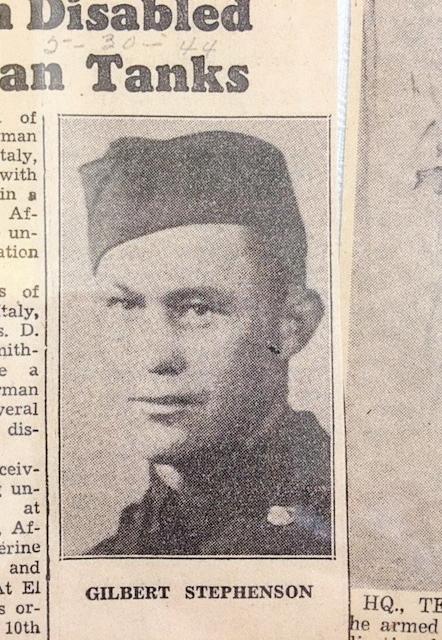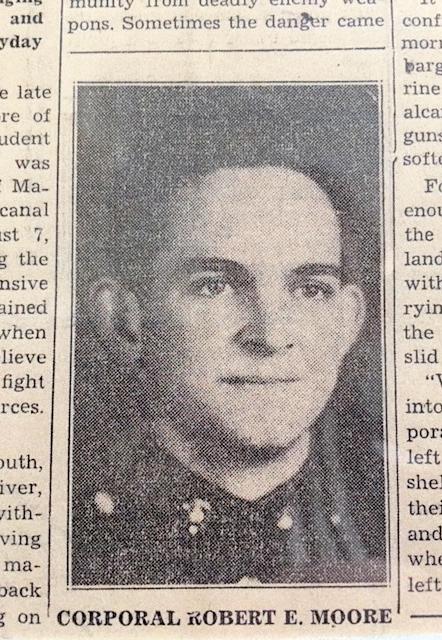
7 minute read
Johnston County servicemen at the turn of the tide
from September 2020
by Johnston Now
By Benjamin Sanderford
It was June 1942 and the war was not going well for Johnston County. Despite the confident tone of the weekly battle report in the Smithfield Herald, the situation was dire on all fronts.
Advertisement
The besieged Soviet city of Sevastopol (Sebastopol), in the Crimean Peninsula, still held out against the Germans and Romanians, but there was no hope of relief.
In Libya, British leaders reported a “success” that became a disaster in which Allied forces barely escaped destruction. Within a few days, they were fleeing into Egypt, pursued by the fabled “Desert Fox” Erwin Rommel and his vaunted GermanItalian Panzerarmee Afrika towards the Suez Canal.
Meanwhile, Japan continued to advance. Although the U.S. Navy had thwarted a Japanese attack at the Battle of the Coral Sea in May, an enemy invasion of Alaska’s Aleutian Islands was imminent. More immediately, a major battle was in progress near Midway Atoll, west of Hawaii.
Glenn Ford, of Smithfield, was there aboard the aircraft carrier USS Hornet. Torpedo bombers and dive bombers from the Hornet, the Enterprise and the Yorktown ambushed the Japanese fleet on June 4. By the evening of June 7, the Yorktown and the destroyer USS Hammann were sunk, but so too were four Japanese carriers and a heavy cruiser.
The Imperial Navy had lost its ability to support a major offensive. Nevertheless, there was still cause for gloom. The number of medical men being drafted, including Dr. Watson Wharton of Smithfield, was creating a shortage of physicians in Johnston County. There were also rumors that coffee, tea and cocoa would soon be rationed.
Looking at the battlefront on June 12, Hugo S. Sims, the war analyst at the Herald, expressed concern that the Chinese, under attack from Japan since 1937, might not have the equipment necessary to hold the enemy back. Sims also heard from experts that a German invasion of Turkey could not be ruled out.
However, it was the expected German summer offensive in Russia that worried Sims the most.
As he noted, it was only two years ago that Scandinavia, the Low Countries and France had all fallen to the armies of the Reich. More ominously, despite the failure to take Moscow back in December, it was clear that Germany still had one last chance to conquer the Soviet Union.
Sims’ worst fears seemed realized when the Germans made their move. Sevastopol finally fell on July 4. By mid-August, German forces had advanced deep into the Caucasus Mountains, threatening the oil fields that fed the Soviet war machine.
Back in the Pacific, the Japanese launched an offensive on New Guinea that would take them to within 30 miles of the capital, Port Moresby. They also began construction of an airfield on the small but strategic island of Guadalcanal. U.S. leaders decided to take it.
On Aug. 7, the Marines waded ashore. One of them was Robert E. Moore, of Elevation. As an ambulance driver, Moore was not expected to fight on the front line, but Guadalcanal would become a place, in the words of the Herald’s Tom Lassiter, “where dodging Japanese shells, bombs and bullets became an everyday pursuit.”
The Americans easily took the airfield, which immediately became a base for fighter planes, but the Japanese high command ordered a counter-offensive to retake the island. There followed a costly back-and-forth series of encounters on land and at sea.
As at Midway, Ford and the Hornet battled the Japanese fleet. Unlike at Midway, however, they were firmly in the enemy’s cross hairs. During an intense battle on Oct. 26, near the Santa Cruz Islands, two waves of Japanese aircraft struck the Hornet, delivering fatal damage. Ford escaped aboard a destroyer before his ship sank.
At this point, the four aircraft carriers and their dozens of experienced naval pilots lost at Midway might have tipped the balance in Japan’s favor, but the Japanese did not have the strength to keep up this campaign of attrition. By the time Moore was rotated off Guadalcanal in December, it was clear that the Americans would win.
Meanwhile, on New Guinea, U.S.- Australian forces were attacking the Japanese bases at Buna and Gona. The fall of these positions marked the end of Japan’s threat to Australia. From the start of 1943 onward, the Japanese would be on the defensive.
A similar situation was developing in Europe. Here, the German dictator, Adolf Hitler, made a fateful intervention. Instead of concentrating all forces on the Caucasian oilfields, he diverted troops to take Stalingrad, the city that bore the name of his Soviet counterpart, Joseph Stalin. The predictable result was that the Germans were unable to take either objective.
Georgy Zhukov, Stalin’s best general, took advantage of German weakness in November 1942 by encircling the German troops bogged down in Stalingrad. Hitler immediately authorized a relief attempt, but forbade his besieged soldiers from breaking out, even after the Soviets had defeated the relief force.
On Feb. 2, the last German holdouts in Stalingrad surrendered due to lack of food and ammunition. By that time, the Germans in the Caucasus had hastily retreated, abandoning all their summer gains. The campaign had cost the Germans over 500,000 killed, wounded or captured for nothing. Germany could no longer win the war with Russia.
At the same time, the war in North Africa was entering a new phase. Britishled forces finally turned the tables on Rommel in November at El Alamein, forcing him into a headlong flight out of Egypt and across the length of Libya. The hounds were closing in on the Desert Fox.
On the other side of Africa’s Mediterranean coast, British and American warships were sailing towards the French colonies of Morocco and Algeria. The colonial authorities there were loyal to the pro-Nazi Vichy regime, but many junior officers were sympathetic to the Allies while the chief official present, Admiral François Darlan, was a ruthless opportunist. French North Africa, the Allies believed, would be a softer target than a region directly occupied by Germany.

The landings, on Nov. 8, 1942, did not go off without a hitch. The Vichy loyalists fired on the Allies and both sides took losses before Darlan, realizing the overwhelming strength of the Allied forces, called a ceasefire. The Germans and Italians reacted immediately by occupying Tunisia, but their advance towards Algeria was thwarted by pro-Allied French troops.
Nevertheless, American soldiers such as Smithfield artilleryman Gilbert Stephenson were in for a hard fight as Axis forces continued to arrive in Tunisia, including Rommel and his veterans.
The wily German commander had a surprise in store for them.
Rommel launched a ferocious attack against inexperienced U.S. troops in February 1943 culminating with the capture of the Kasserine Pass on the twentieth. The battle was embarrassing for the Americans, but it taught them valuable lessons.
A couple weeks later, after a bruising fight with the British troops who had pursued him from Egypt, Rommel concluded that the combined Allied armies were too strong to defeat. On March 10, he went to Hitler’s headquarters and implored his leader to order an evacuation of Tunisia.
Hitler fired him on the spot. As at Stalingrad, the Nazi tyrant had become obsessed with holding ground.

By the end of the month, U.S., British and French forces were all advancing. Stephenson’s battalion gained a measure of retribution for Kasserine Pass by bombarding German positions at El Guettar and Fondouk, where it knocked out 23 enemy tanks. The Germans and Italians continued to resist fiercely throughout April, but they could not stop the Allies.
The Axis positions finally collapsed in early May, and their last troops surrendered on the thirteenth. Around 250,000 Germans and Italians were taken prisoner in Tunisia. Hitler’s hubris had once again proved catastrophic for the Reich and its partners.
It had been a momentous year. In mid1942, the Allies were wringing their hands about what the enemy might do. Now, in mid-1943, Japan was halted at Midway and turned back at Guadalcanal and Germany was badly mauled in Russia and North Africa while Italy was vulnerable to Allied invasion. It was only a matter of time before the Axis was defeated. The courage and skill of Johnston County’s soldiers, sailors and Marines would be needed to finish the job.
Benjamin Sanderford, a resident of Clayton, studied social science at UNC Greensboro. He can be reached at benwsanderford@gmail.com.










